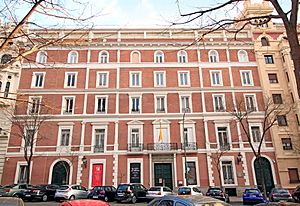Museo Nacional de Artes Decorativas facts for kids
| Museo Nacional de Artes Decorativas | |
 |
|
| Former name | National Museum of Industrial Arts |
|---|---|
| Established | 1912 |
| Location | Madrid, Spain |
The National Museum of Decorative Arts (in Spanish, Museo Nacional de Artes Decorativas) is a special museum in Madrid, Spain. It shows off beautiful objects that are also useful, like furniture, pottery, glass, and fabrics. These are sometimes called "decorative arts" or "minor arts." It's one of Spain's important National Museums and is part of the Ministry of Culture.
This museum is one of the oldest in Madrid. It's located in a famous area called the Golden Triangle of Art, near the Alcalá Gate and the Buen Retiro Park. Like the Victoria and Albert Museum in London, it helps us see how these useful and artistic items have changed over time. The museum has about 70,000 pieces, with many from the 16th and 17th centuries. You can explore 62 rooms filled with amazing displays. In 2017, over 71,000 people visited the museum.
Contents
History of the Museum
The National Museum of Decorative Arts started in 1912. It was first called the National Museum of Industrial Arts. The idea for it came from an earlier Industrial Museum. When it first opened, the museum was more like a school. It helped artists, makers, and designers learn new skills. It was similar to famous museums in London and Paris that also focused on decorative arts. The museum has always paid special attention to items from the 16th and 17th centuries. It has also worked with other countries, like when it hosted an art show from Mexico in 1933.
The Museum Building
The museum first opened in a building on Sacramento Street, with six rooms. In 1932, it moved to its current home on Montalbán Street. This building is a beautiful 19th-century mansion. It was built in the 1880s for the Duchess of Santoña. Later, in 1909, it became a school for teachers. The Spanish government bought the building in 1941 and made some important improvements. In 1962, the building and its collections were declared a Bien de Interés Cultural. This means it's a very important historical and artistic site. The museum has 62 rooms spread across five floors.
Amazing Collections
The National Museum of Decorative Arts is one of the biggest and most interesting museums in Madrid. It has many different types of collections. You can see ceramics, furniture, jewelry, textiles, and art from Asia. The museum has about 40,000 objects in total. Some of these pieces, about 15,000, are loaned to other museums. The museum mostly focuses on Spanish decorative arts. However, it also has examples from other countries, especially ceramics and fancy items that were brought to Spain long ago. Some rooms in the museum are set up to look like scenes from the past. They use original furniture and objects, including examples of 18th-century kitchens.
Furniture Collection
The museum has a great collection of furniture, especially from the 14th century onwards. Furniture from very old times is rare, so these pieces are special. The collection of Gothic to Baroque furniture is the best you can find in a public museum in Spain. You can see writing desks, chairs, and many other types of furniture.
Asian Art Collection
The Asian art collection features beautiful porcelain from the Ming (1368-1644) and Qing (1644-1912) dynasties of China. Some of these porcelain pieces were even made in China specifically for Spanish families, showing their family symbols. The collection also includes Chinese royal robes, musical instruments, scroll paintings, and bronze objects.
Ceramics and Glass
The ceramics section has about 4,000 pieces made from clay, pottery, and porcelain. The oldest piece is an 11th-century jar from Toledo. You can see examples from famous Spanish pottery centers like Manises, Talavera de la Reina, and El Puente del Arzobispo. The Spanish porcelain section includes pieces from important factories like Porcelana de Alcora and Real Fábrica del Buen Retiro. There are also pieces from famous European factories like Sèvres and Limoges.
The glass collection is huge! It includes glass from ancient Greece (4th century BC), the Roman Empire, and the Visigoths. There are also unique glass pieces by René Lalique and from the Real Fábrica de Cristales de La Granja (a Spanish glass factory) from the 1700s and 1800s.
Textiles and Metalwork
The textile collection includes clothing (both everyday and religious) and items for the home. You can see beautiful silk from 15th-century Granada. There are pieces from the 2nd century all the way to today. The collection features different types of cloth like damask, velvet, and lace. These are made into items like fans, purses, and dance cards. The museum also has very rare carpets from Cuenca and Alcaraz from the 15th to 17th centuries.
The metalwork collection has a variety of items. These range from bracelets from the Sahara Desert and Moroccan fibulas (decorative pins) to Turkish inkpots from the 18th and 19th centuries, and Korean cases.
Notable People
- Isabel de Ceballos-Escalera (1919-1990), a director of the National Museum of Decorative Arts.
See also
 In Spanish: Museo Nacional de Artes Decorativas para niños
In Spanish: Museo Nacional de Artes Decorativas para niños

